New York City is a BIG place, yet everything you can want is usually within walking distance, and if not you can
pay a nickel to ride on 293 miles of subway and elevated tracks, 437 miles of street trolleys or 239 miles of bus routes. In 1939 the competing BMT, IRT and
Independent lines became unified.
 Grand Central Terminal - (1913), the Grand Central Terminal was the main hub for rail travel
in and out of NYC, With 44 platforms servicing 67 lines coming in on two levels (41 tracks on the upper level and 26 on the lower).
Above the main entrance of the terminal is a sculpture of Hermes, the herald of the Olympic gods standing on top of a clock. On the ceiling of
the main concourse, a mural of stars is presented including the zodiac, which was painted in reverse as if looking from above.
There are also many secret passages, one of which leads to a train platform under the Waldorf-Astoria hotel. President Roosevelt used this
in order to avoid reporters on his trips to the Big Apple. On the lower level of the terminal resides the Oyster Bar which also opened in 1913.
Grand Central Terminal - (1913), the Grand Central Terminal was the main hub for rail travel
in and out of NYC, With 44 platforms servicing 67 lines coming in on two levels (41 tracks on the upper level and 26 on the lower).
Above the main entrance of the terminal is a sculpture of Hermes, the herald of the Olympic gods standing on top of a clock. On the ceiling of
the main concourse, a mural of stars is presented including the zodiac, which was painted in reverse as if looking from above.
There are also many secret passages, one of which leads to a train platform under the Waldorf-Astoria hotel. President Roosevelt used this
in order to avoid reporters on his trips to the Big Apple. On the lower level of the terminal resides the Oyster Bar which also opened in 1913.
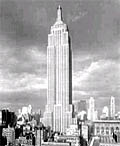 Empire State Building - (1931) The endeavor was a
purely commercial effort in competition with the builders of the 40 Wall St and Chryster buildings to make the world's tallest building. At 102 stories (1250 ft),
the Empire State building won the competition and remained the tallest in the world until 1972. Construction of the Empire State Building began on
March 17, 1930 on the site of the former Waldorf-Astoria Hotel and was officially opened May 1, 1931.
The total cost of the building including the land to build it on was $40,948,900. Construction required the use of up to 3400 workers working 7 million man hours over the period of
1 year & 45 days includings Sundays and holidays. By official accounts, and only 5 men died during the construction. The building itself is wrapped in Indiana limestone
and granite, aluminum and chrome nickel steel.
There are observation decks on the 86th and 102nd floors which were originally to be used as a mooring mast and depot for dirigibles.
Empire State Building - (1931) The endeavor was a
purely commercial effort in competition with the builders of the 40 Wall St and Chryster buildings to make the world's tallest building. At 102 stories (1250 ft),
the Empire State building won the competition and remained the tallest in the world until 1972. Construction of the Empire State Building began on
March 17, 1930 on the site of the former Waldorf-Astoria Hotel and was officially opened May 1, 1931.
The total cost of the building including the land to build it on was $40,948,900. Construction required the use of up to 3400 workers working 7 million man hours over the period of
1 year & 45 days includings Sundays and holidays. By official accounts, and only 5 men died during the construction. The building itself is wrapped in Indiana limestone
and granite, aluminum and chrome nickel steel.
There are observation decks on the 86th and 102nd floors which were originally to be used as a mooring mast and depot for dirigibles.
Rockefeller Center - (1931-1939) This commercial and entertainment district is a collection of 14 buildings in the style
Art-Deco. Some of the most notable buildings include the Radio City Music Hall (1932) which was the largest and most opulent theater in the world
and could seat 5933 people. In 1933 it hosted the world premiere of King Kong. The RCA building (1933) is a 70 story skyscraper whose principle tenant in the 30s was RCA/NBC which was one of the few corporations
that was actually thriving during the Great Depression. In 1936 the Ice Skating rink was opened, and in 1937 the sculpture of Atlas was unveiled to
protests that it resembled Mussolini.
Coney Island - Not really an Island, Coney Island is a peninsula on the south end of Brooklyn
and was home to a myriad of entertainment venues. Two competing amusement parks were in operation during the 1930s Luna Park & Steeplechase Park,
but with the Great depression, they struggled to stay afloat as the area became a "Nickel Empire" of cheap amusements; a nickel paid the fare on
the new subway line and paid for a five-cent hot dog. Besides the amusement parks, Coney Island had many other attractions including the beach,
a 3 mile long boardwalk, side-shows, hotels & bathhouses.
Central Park - Designed in the mid 1800s to be a playground for the wealthy, Central Park was
the first landscaped urban park in the United States. In 1934 Fiorello LaGuardia,
newly elected mayor of New York, consolidated the various park departments that controlled Central Park in an effort to clean it up, as it was
the target of vandals and had fallen into disrepair. During this time a major redesign was also implemented, which included filling in the existing
Croton Lower Reservoir so that the Great Lawn could be created.
One distinctive landmark in the park is "Cleopatra's Needle," a red granite obelisk,
inscribed with Egyptian hieroglyphs. In 1881, the 3500 year old artifact was donated to New York by the Khedive of Egypt.
It is one of three, with the others being in London and Paris.
Times Square - (1904) Times Square is a major intersection in Manhatten and was named after the New York Times building that became the cornerstone of the new district.
Unfortunatly, the Great depression hit the area hard, turning once-elegant restaurants into cheap luncheonettes and once flourishing theatres had turned into movie houses. Crime also kept many visitors away from the area's hotels.

Savoy Ballroom - Harlem
Savoy, the home of sweet romance,
Savoy, it wins you with a glance,
Savoy, gives happy feet a chance to dance.
The Big Apple?
 They were so glad now to come to New York, where the big
money was. The city was so huge to them and so full of
opportunity that they called it the 'Big Apple.'
They were so glad now to come to New York, where the big
money was. The city was so huge to them and so full of
opportunity that they called it the 'Big Apple.'

The origins of the term "The Big Apple" is believed to have come from The Daily Racing Form in the New York Morning Telegraph, where, in 1920, the term was coined by John J. FitzGerald in reference to the horse racing industry in the city.
Though it isn't known for sure when NYC itself was nick-named
the big apple, the term was commonly used in the 1930s by Jazz musicians, usually in reference to playing in Manhatten which ment playing to the
biggest and most favorable audiences in the United States, if you were playing in the Big Apple, you were playing the Big Time!. It was also the name of a popular jazz nightclub located in Harlem, a popular
swing dance or it could have been in reference to the thousands of apple vendors on the sidewalks during the great depression.
Crime in the Big Apple.
Besides Chicago, lots of Gangsters liked to call New York City home. After the Castellammarese War, Salvatore Maranzano was considered the "Boss of Bosses, at least until "Lucky" Luciano had him snuffed out. In his place The Commission, an organization of five families was formed.
Besides the Sicilian mafia, there was also a large contingent of Jewish gangsters as well as well
The Great Depression
The
effects of Great Depression were evident all around the Big Apple with the unemployed
standing in long breadlines and soup kitchens for food while others found
themselves living in homeless encampments called Hoovervilles.
|
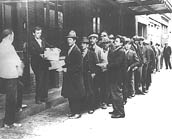
|
I'm
spending my nights at the flophouse -
I'm spending my days on the street.
I'm looking for work and I find some
I wish I had something to eat!
Sou-oopp! Sou-oop!
They give me a bowl of sou-oo-oop
Sou-oopp! Sou-oop!
They give me a bowl of soup. |
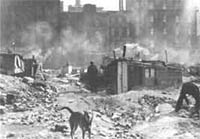
|
It is estimated
that in 1932 there were 750,000 on city assistance with an additional 160,000 on
the waiting list. Some enterprising New Yorkers, around 6000, sold apples out of
carts on the street corners for a nickel apiece.
Despite the grimness of it all,
the city still saw amazing growth with the construction of some of the worlds largest skyscrapers many
using Art-Deco in their both their design and decoration. with the most famous
examples being the Chrysler Building (1930) and the Empire State Building (1931)
Even through the turmoil of the Dirty 30s! New York City was known as a center for industry, commerce, and communication.


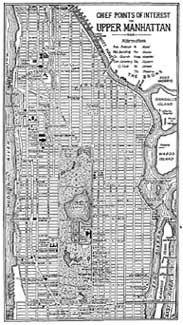

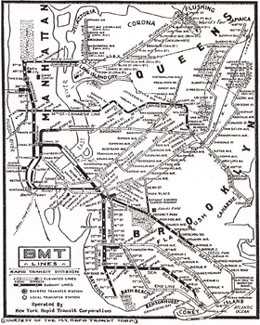
 Grand Central Terminal - (1913), the Grand Central Terminal was the main hub for rail travel
in and out of NYC, With 44 platforms servicing 67 lines coming in on two levels (41 tracks on the upper level and 26 on the lower).
Above the main entrance of the terminal is a sculpture of Hermes, the herald of the Olympic gods standing on top of a clock. On the ceiling of
the main concourse, a mural of stars is presented including the zodiac, which was painted in reverse as if looking from above.
There are also many secret passages, one of which leads to a train platform under the Waldorf-Astoria hotel. President Roosevelt used this
in order to avoid reporters on his trips to the Big Apple. On the lower level of the terminal resides the Oyster Bar which also opened in 1913.
Grand Central Terminal - (1913), the Grand Central Terminal was the main hub for rail travel
in and out of NYC, With 44 platforms servicing 67 lines coming in on two levels (41 tracks on the upper level and 26 on the lower).
Above the main entrance of the terminal is a sculpture of Hermes, the herald of the Olympic gods standing on top of a clock. On the ceiling of
the main concourse, a mural of stars is presented including the zodiac, which was painted in reverse as if looking from above.
There are also many secret passages, one of which leads to a train platform under the Waldorf-Astoria hotel. President Roosevelt used this
in order to avoid reporters on his trips to the Big Apple. On the lower level of the terminal resides the Oyster Bar which also opened in 1913.
 Empire State Building - (1931) The endeavor was a
purely commercial effort in competition with the builders of the 40 Wall St and Chryster buildings to make the world's tallest building. At 102 stories (1250 ft),
the Empire State building won the competition and remained the tallest in the world until 1972. Construction of the Empire State Building began on
March 17, 1930 on the site of the former Waldorf-Astoria Hotel and was officially opened May 1, 1931.
The total cost of the building including the land to build it on was $40,948,900. Construction required the use of up to 3400 workers working 7 million man hours over the period of
1 year & 45 days includings Sundays and holidays. By official accounts, and only 5 men died during the construction. The building itself is wrapped in Indiana limestone
and granite, aluminum and chrome nickel steel.
There are observation decks on the 86th and 102nd floors which were originally to be used as a mooring mast and depot for dirigibles.
Empire State Building - (1931) The endeavor was a
purely commercial effort in competition with the builders of the 40 Wall St and Chryster buildings to make the world's tallest building. At 102 stories (1250 ft),
the Empire State building won the competition and remained the tallest in the world until 1972. Construction of the Empire State Building began on
March 17, 1930 on the site of the former Waldorf-Astoria Hotel and was officially opened May 1, 1931.
The total cost of the building including the land to build it on was $40,948,900. Construction required the use of up to 3400 workers working 7 million man hours over the period of
1 year & 45 days includings Sundays and holidays. By official accounts, and only 5 men died during the construction. The building itself is wrapped in Indiana limestone
and granite, aluminum and chrome nickel steel.
There are observation decks on the 86th and 102nd floors which were originally to be used as a mooring mast and depot for dirigibles.

 They were so glad now to come to New York, where the big
money was. The city was so huge to them and so full of
opportunity that they called it the 'Big Apple.'
They were so glad now to come to New York, where the big
money was. The city was so huge to them and so full of
opportunity that they called it the 'Big Apple.'

